Ethnographic Report: An Anthropological View of Canadian Culture
VerifiedAdded on 2023/06/03
|7
|1910
|76
Report
AI Summary
This report, an ethnographic study for an Introduction to Cultural Anthropology course, analyzes Canadian culture through observations and interviews conducted in a Montreal park. The student explores various aspects of human behavior, communication styles, and emotional intelligence among ten participants. The study highlights the diversity of opinions regarding culture and taboos within Canadian society. The research delves into the influence of cultural conventions, such as human emotions and communication styles. The author also discusses the impact of cultural influences, drawing comparisons to the behaviors and perspectives of individuals from other cultures. The report concludes with a reflection on the individualistic nature of Canadians and their diverse perspectives on being well-mannered.
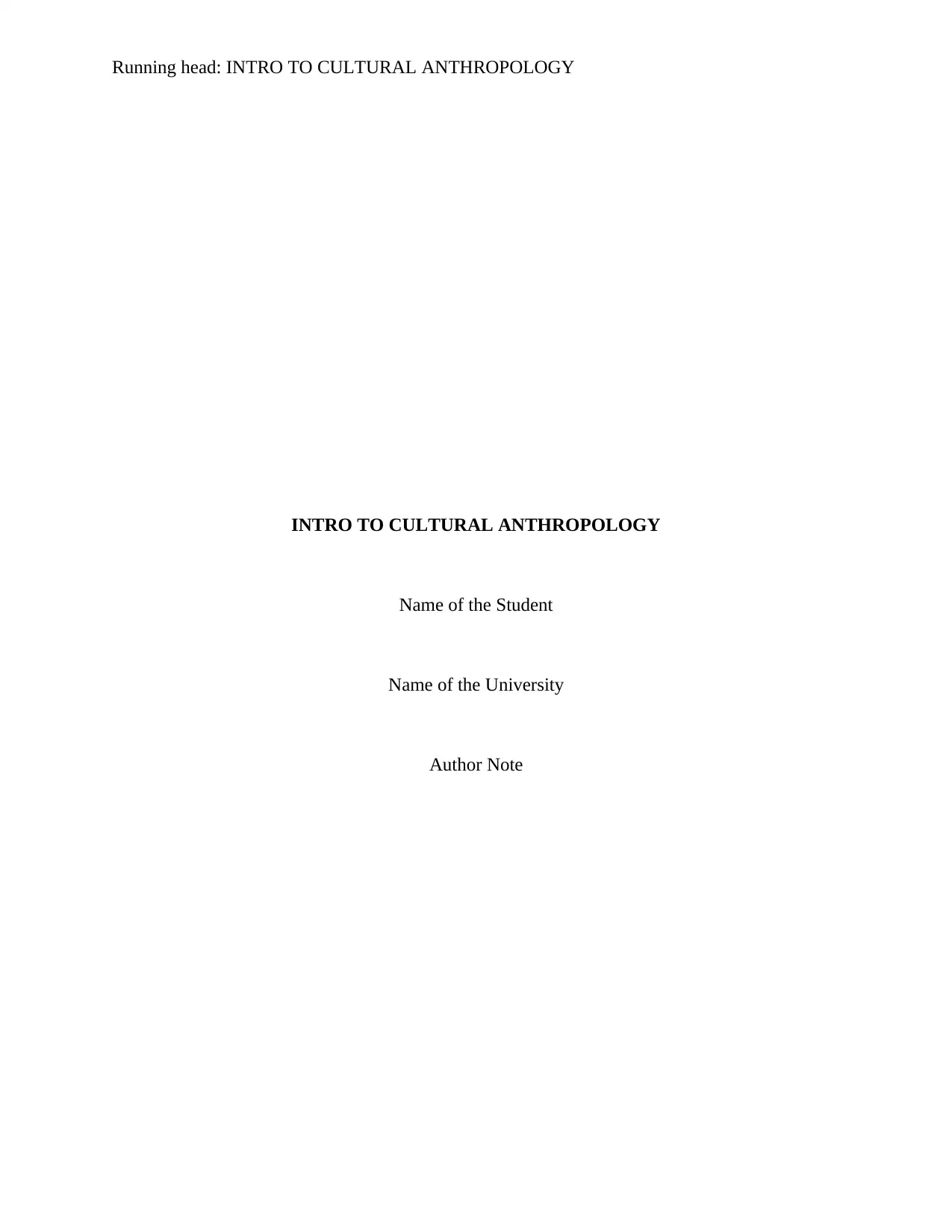
Running head: INTRO TO CULTURAL ANTHROPOLOGY
INTRO TO CULTURAL ANTHROPOLOGY
Name of the Student
Name of the University
Author Note
INTRO TO CULTURAL ANTHROPOLOGY
Name of the Student
Name of the University
Author Note
Paraphrase This Document
Need a fresh take? Get an instant paraphrase of this document with our AI Paraphraser
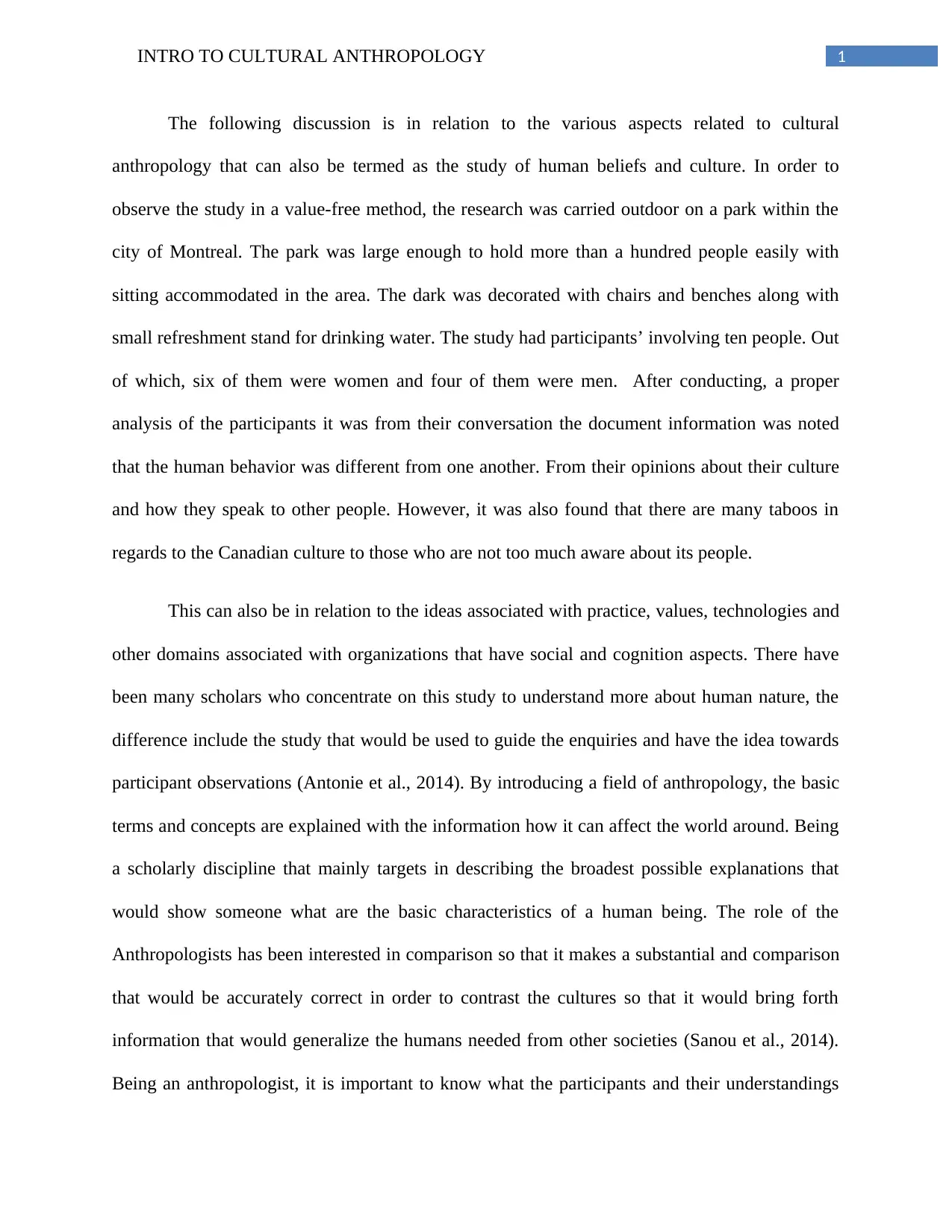
1INTRO TO CULTURAL ANTHROPOLOGY
The following discussion is in relation to the various aspects related to cultural
anthropology that can also be termed as the study of human beliefs and culture. In order to
observe the study in a value-free method, the research was carried outdoor on a park within the
city of Montreal. The park was large enough to hold more than a hundred people easily with
sitting accommodated in the area. The dark was decorated with chairs and benches along with
small refreshment stand for drinking water. The study had participants’ involving ten people. Out
of which, six of them were women and four of them were men. After conducting, a proper
analysis of the participants it was from their conversation the document information was noted
that the human behavior was different from one another. From their opinions about their culture
and how they speak to other people. However, it was also found that there are many taboos in
regards to the Canadian culture to those who are not too much aware about its people.
This can also be in relation to the ideas associated with practice, values, technologies and
other domains associated with organizations that have social and cognition aspects. There have
been many scholars who concentrate on this study to understand more about human nature, the
difference include the study that would be used to guide the enquiries and have the idea towards
participant observations (Antonie et al., 2014). By introducing a field of anthropology, the basic
terms and concepts are explained with the information how it can affect the world around. Being
a scholarly discipline that mainly targets in describing the broadest possible explanations that
would show someone what are the basic characteristics of a human being. The role of the
Anthropologists has been interested in comparison so that it makes a substantial and comparison
that would be accurately correct in order to contrast the cultures so that it would bring forth
information that would generalize the humans needed from other societies (Sanou et al., 2014).
Being an anthropologist, it is important to know what the participants and their understandings
The following discussion is in relation to the various aspects related to cultural
anthropology that can also be termed as the study of human beliefs and culture. In order to
observe the study in a value-free method, the research was carried outdoor on a park within the
city of Montreal. The park was large enough to hold more than a hundred people easily with
sitting accommodated in the area. The dark was decorated with chairs and benches along with
small refreshment stand for drinking water. The study had participants’ involving ten people. Out
of which, six of them were women and four of them were men. After conducting, a proper
analysis of the participants it was from their conversation the document information was noted
that the human behavior was different from one another. From their opinions about their culture
and how they speak to other people. However, it was also found that there are many taboos in
regards to the Canadian culture to those who are not too much aware about its people.
This can also be in relation to the ideas associated with practice, values, technologies and
other domains associated with organizations that have social and cognition aspects. There have
been many scholars who concentrate on this study to understand more about human nature, the
difference include the study that would be used to guide the enquiries and have the idea towards
participant observations (Antonie et al., 2014). By introducing a field of anthropology, the basic
terms and concepts are explained with the information how it can affect the world around. Being
a scholarly discipline that mainly targets in describing the broadest possible explanations that
would show someone what are the basic characteristics of a human being. The role of the
Anthropologists has been interested in comparison so that it makes a substantial and comparison
that would be accurately correct in order to contrast the cultures so that it would bring forth
information that would generalize the humans needed from other societies (Sanou et al., 2014).
Being an anthropologist, it is important to know what the participants and their understandings
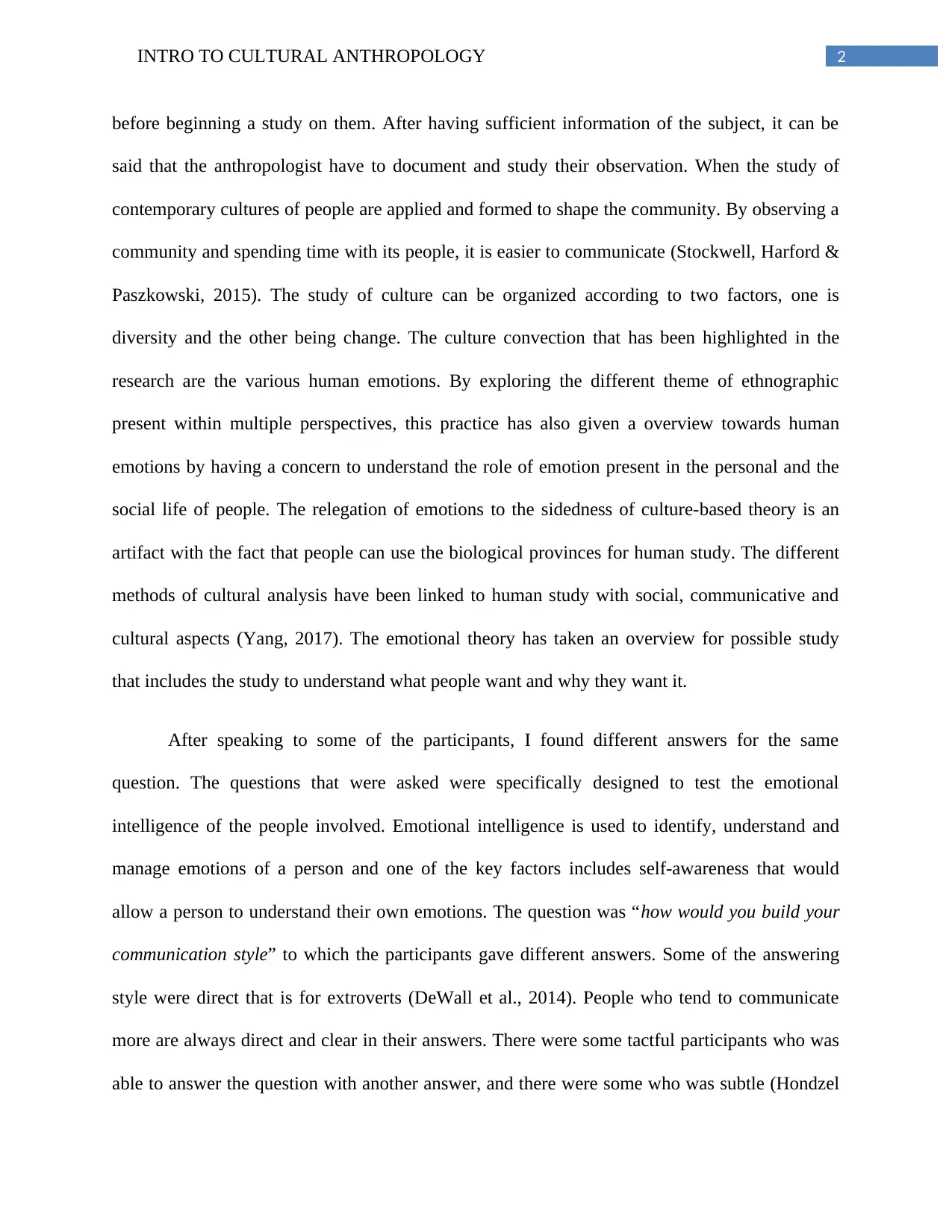
2INTRO TO CULTURAL ANTHROPOLOGY
before beginning a study on them. After having sufficient information of the subject, it can be
said that the anthropologist have to document and study their observation. When the study of
contemporary cultures of people are applied and formed to shape the community. By observing a
community and spending time with its people, it is easier to communicate (Stockwell, Harford &
Paszkowski, 2015). The study of culture can be organized according to two factors, one is
diversity and the other being change. The culture convection that has been highlighted in the
research are the various human emotions. By exploring the different theme of ethnographic
present within multiple perspectives, this practice has also given a overview towards human
emotions by having a concern to understand the role of emotion present in the personal and the
social life of people. The relegation of emotions to the sidedness of culture-based theory is an
artifact with the fact that people can use the biological provinces for human study. The different
methods of cultural analysis have been linked to human study with social, communicative and
cultural aspects (Yang, 2017). The emotional theory has taken an overview for possible study
that includes the study to understand what people want and why they want it.
After speaking to some of the participants, I found different answers for the same
question. The questions that were asked were specifically designed to test the emotional
intelligence of the people involved. Emotional intelligence is used to identify, understand and
manage emotions of a person and one of the key factors includes self-awareness that would
allow a person to understand their own emotions. The question was “how would you build your
communication style” to which the participants gave different answers. Some of the answering
style were direct that is for extroverts (DeWall et al., 2014). People who tend to communicate
more are always direct and clear in their answers. There were some tactful participants who was
able to answer the question with another answer, and there were some who was subtle (Hondzel
before beginning a study on them. After having sufficient information of the subject, it can be
said that the anthropologist have to document and study their observation. When the study of
contemporary cultures of people are applied and formed to shape the community. By observing a
community and spending time with its people, it is easier to communicate (Stockwell, Harford &
Paszkowski, 2015). The study of culture can be organized according to two factors, one is
diversity and the other being change. The culture convection that has been highlighted in the
research are the various human emotions. By exploring the different theme of ethnographic
present within multiple perspectives, this practice has also given a overview towards human
emotions by having a concern to understand the role of emotion present in the personal and the
social life of people. The relegation of emotions to the sidedness of culture-based theory is an
artifact with the fact that people can use the biological provinces for human study. The different
methods of cultural analysis have been linked to human study with social, communicative and
cultural aspects (Yang, 2017). The emotional theory has taken an overview for possible study
that includes the study to understand what people want and why they want it.
After speaking to some of the participants, I found different answers for the same
question. The questions that were asked were specifically designed to test the emotional
intelligence of the people involved. Emotional intelligence is used to identify, understand and
manage emotions of a person and one of the key factors includes self-awareness that would
allow a person to understand their own emotions. The question was “how would you build your
communication style” to which the participants gave different answers. Some of the answering
style were direct that is for extroverts (DeWall et al., 2014). People who tend to communicate
more are always direct and clear in their answers. There were some tactful participants who was
able to answer the question with another answer, and there were some who was subtle (Hondzel
⊘ This is a preview!⊘
Do you want full access?
Subscribe today to unlock all pages.

Trusted by 1+ million students worldwide
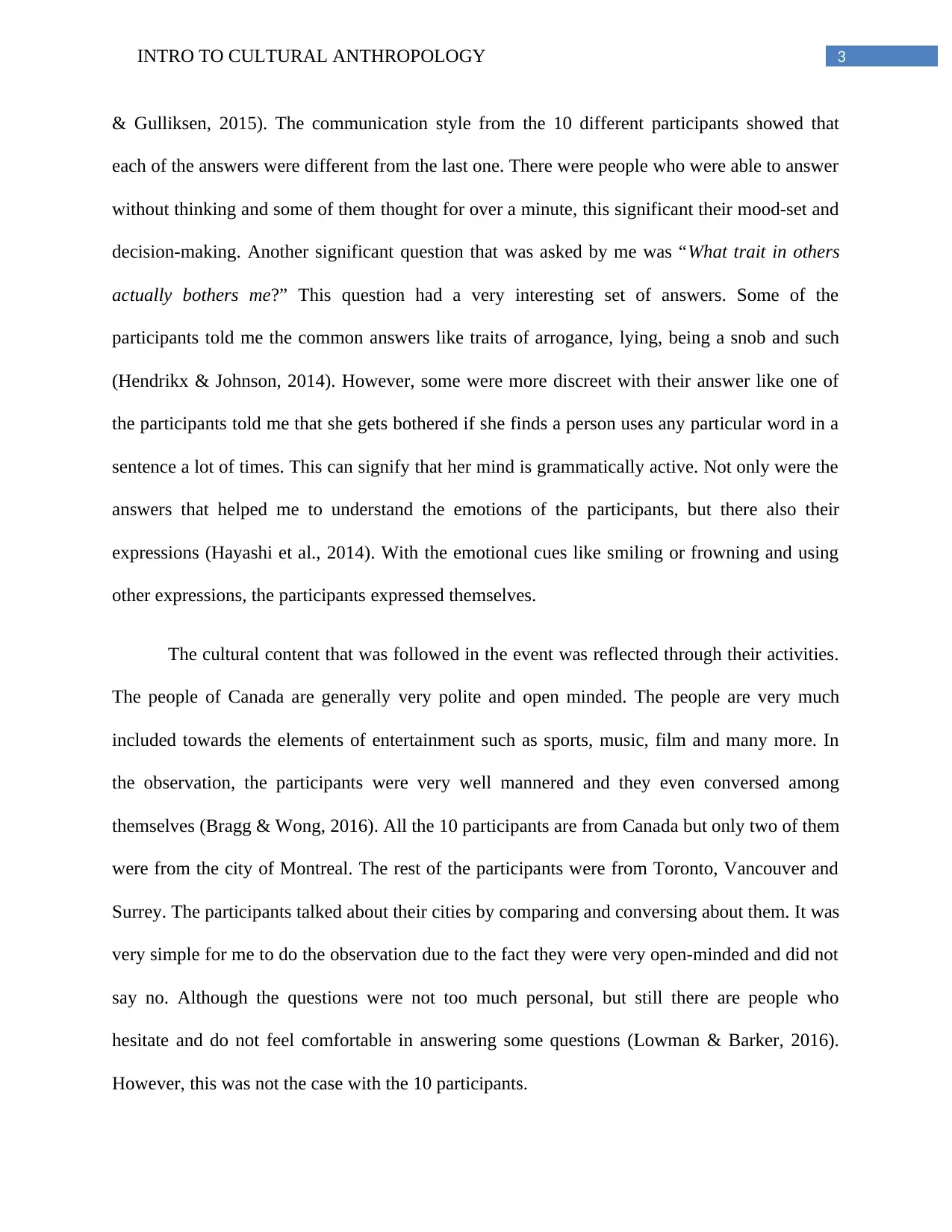
3INTRO TO CULTURAL ANTHROPOLOGY
& Gulliksen, 2015). The communication style from the 10 different participants showed that
each of the answers were different from the last one. There were people who were able to answer
without thinking and some of them thought for over a minute, this significant their mood-set and
decision-making. Another significant question that was asked by me was “What trait in others
actually bothers me?” This question had a very interesting set of answers. Some of the
participants told me the common answers like traits of arrogance, lying, being a snob and such
(Hendrikx & Johnson, 2014). However, some were more discreet with their answer like one of
the participants told me that she gets bothered if she finds a person uses any particular word in a
sentence a lot of times. This can signify that her mind is grammatically active. Not only were the
answers that helped me to understand the emotions of the participants, but there also their
expressions (Hayashi et al., 2014). With the emotional cues like smiling or frowning and using
other expressions, the participants expressed themselves.
The cultural content that was followed in the event was reflected through their activities.
The people of Canada are generally very polite and open minded. The people are very much
included towards the elements of entertainment such as sports, music, film and many more. In
the observation, the participants were very well mannered and they even conversed among
themselves (Bragg & Wong, 2016). All the 10 participants are from Canada but only two of them
were from the city of Montreal. The rest of the participants were from Toronto, Vancouver and
Surrey. The participants talked about their cities by comparing and conversing about them. It was
very simple for me to do the observation due to the fact they were very open-minded and did not
say no. Although the questions were not too much personal, but still there are people who
hesitate and do not feel comfortable in answering some questions (Lowman & Barker, 2016).
However, this was not the case with the 10 participants.
& Gulliksen, 2015). The communication style from the 10 different participants showed that
each of the answers were different from the last one. There were people who were able to answer
without thinking and some of them thought for over a minute, this significant their mood-set and
decision-making. Another significant question that was asked by me was “What trait in others
actually bothers me?” This question had a very interesting set of answers. Some of the
participants told me the common answers like traits of arrogance, lying, being a snob and such
(Hendrikx & Johnson, 2014). However, some were more discreet with their answer like one of
the participants told me that she gets bothered if she finds a person uses any particular word in a
sentence a lot of times. This can signify that her mind is grammatically active. Not only were the
answers that helped me to understand the emotions of the participants, but there also their
expressions (Hayashi et al., 2014). With the emotional cues like smiling or frowning and using
other expressions, the participants expressed themselves.
The cultural content that was followed in the event was reflected through their activities.
The people of Canada are generally very polite and open minded. The people are very much
included towards the elements of entertainment such as sports, music, film and many more. In
the observation, the participants were very well mannered and they even conversed among
themselves (Bragg & Wong, 2016). All the 10 participants are from Canada but only two of them
were from the city of Montreal. The rest of the participants were from Toronto, Vancouver and
Surrey. The participants talked about their cities by comparing and conversing about them. It was
very simple for me to do the observation due to the fact they were very open-minded and did not
say no. Although the questions were not too much personal, but still there are people who
hesitate and do not feel comfortable in answering some questions (Lowman & Barker, 2016).
However, this was not the case with the 10 participants.
Paraphrase This Document
Need a fresh take? Get an instant paraphrase of this document with our AI Paraphraser
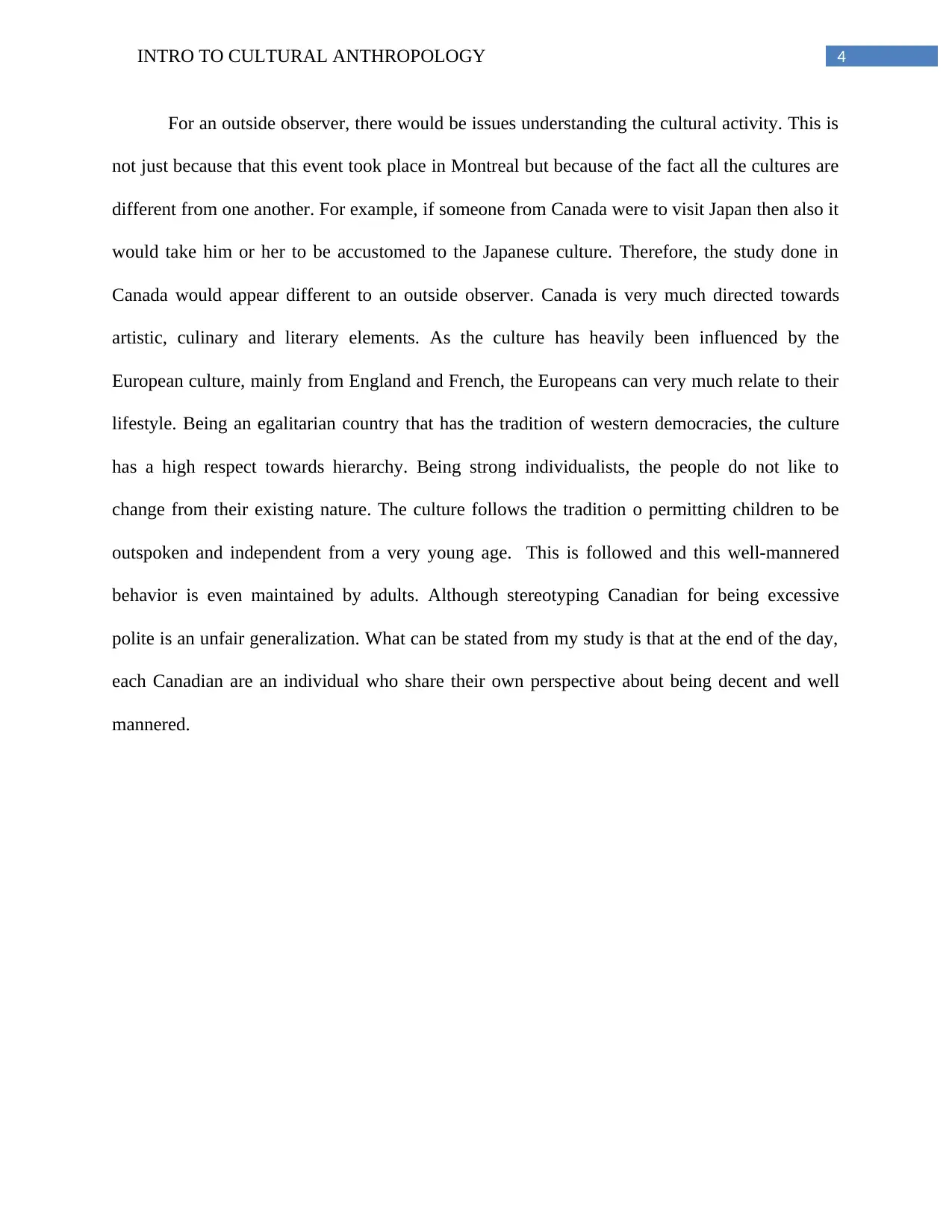
4INTRO TO CULTURAL ANTHROPOLOGY
For an outside observer, there would be issues understanding the cultural activity. This is
not just because that this event took place in Montreal but because of the fact all the cultures are
different from one another. For example, if someone from Canada were to visit Japan then also it
would take him or her to be accustomed to the Japanese culture. Therefore, the study done in
Canada would appear different to an outside observer. Canada is very much directed towards
artistic, culinary and literary elements. As the culture has heavily been influenced by the
European culture, mainly from England and French, the Europeans can very much relate to their
lifestyle. Being an egalitarian country that has the tradition of western democracies, the culture
has a high respect towards hierarchy. Being strong individualists, the people do not like to
change from their existing nature. The culture follows the tradition o permitting children to be
outspoken and independent from a very young age. This is followed and this well-mannered
behavior is even maintained by adults. Although stereotyping Canadian for being excessive
polite is an unfair generalization. What can be stated from my study is that at the end of the day,
each Canadian are an individual who share their own perspective about being decent and well
mannered.
For an outside observer, there would be issues understanding the cultural activity. This is
not just because that this event took place in Montreal but because of the fact all the cultures are
different from one another. For example, if someone from Canada were to visit Japan then also it
would take him or her to be accustomed to the Japanese culture. Therefore, the study done in
Canada would appear different to an outside observer. Canada is very much directed towards
artistic, culinary and literary elements. As the culture has heavily been influenced by the
European culture, mainly from England and French, the Europeans can very much relate to their
lifestyle. Being an egalitarian country that has the tradition of western democracies, the culture
has a high respect towards hierarchy. Being strong individualists, the people do not like to
change from their existing nature. The culture follows the tradition o permitting children to be
outspoken and independent from a very young age. This is followed and this well-mannered
behavior is even maintained by adults. Although stereotyping Canadian for being excessive
polite is an unfair generalization. What can be stated from my study is that at the end of the day,
each Canadian are an individual who share their own perspective about being decent and well
mannered.
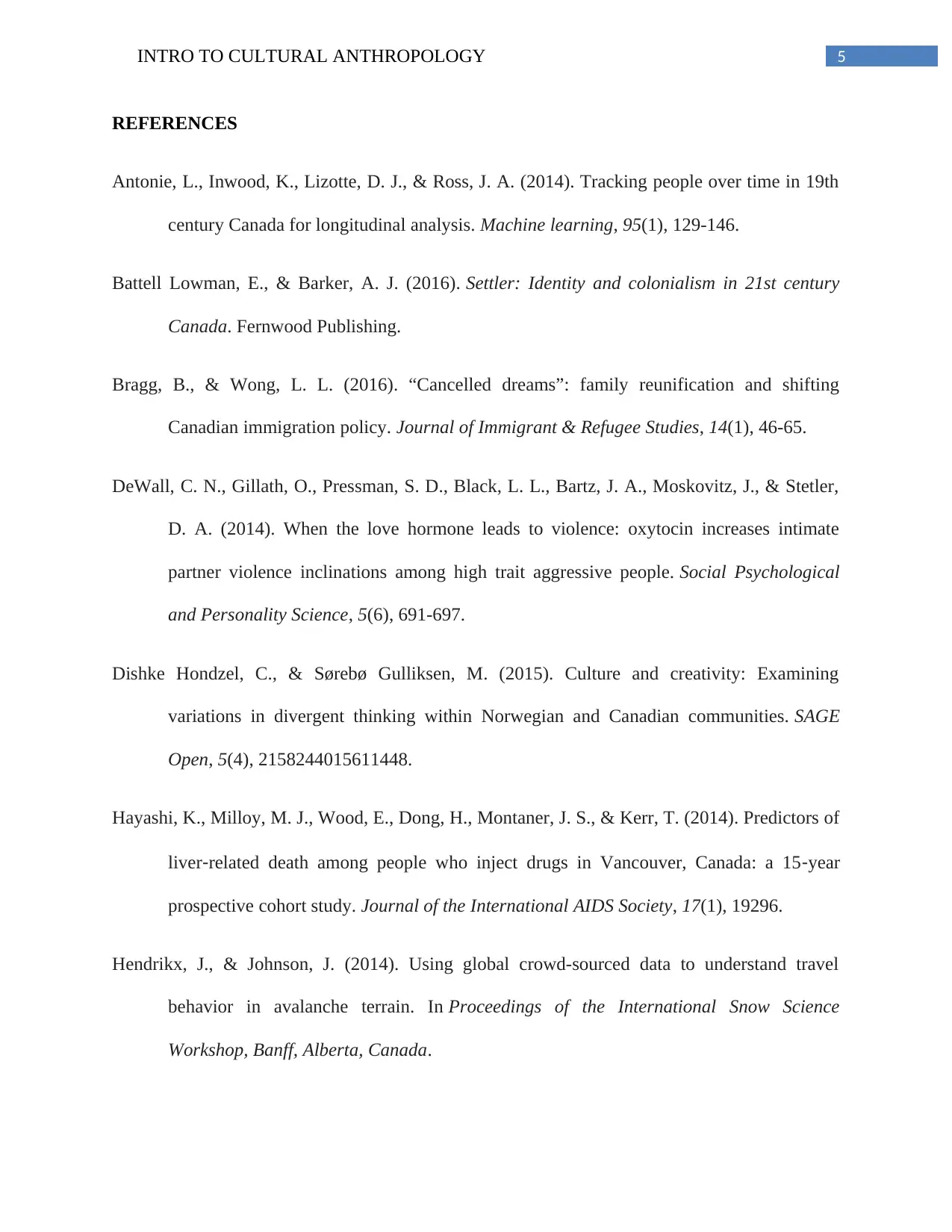
5INTRO TO CULTURAL ANTHROPOLOGY
REFERENCES
Antonie, L., Inwood, K., Lizotte, D. J., & Ross, J. A. (2014). Tracking people over time in 19th
century Canada for longitudinal analysis. Machine learning, 95(1), 129-146.
Battell Lowman, E., & Barker, A. J. (2016). Settler: Identity and colonialism in 21st century
Canada. Fernwood Publishing.
Bragg, B., & Wong, L. L. (2016). “Cancelled dreams”: family reunification and shifting
Canadian immigration policy. Journal of Immigrant & Refugee Studies, 14(1), 46-65.
DeWall, C. N., Gillath, O., Pressman, S. D., Black, L. L., Bartz, J. A., Moskovitz, J., & Stetler,
D. A. (2014). When the love hormone leads to violence: oxytocin increases intimate
partner violence inclinations among high trait aggressive people. Social Psychological
and Personality Science, 5(6), 691-697.
Dishke Hondzel, C., & Sørebø Gulliksen, M. (2015). Culture and creativity: Examining
variations in divergent thinking within Norwegian and Canadian communities. SAGE
Open, 5(4), 2158244015611448.
Hayashi, K., Milloy, M. J., Wood, E., Dong, H., Montaner, J. S., & Kerr, T. (2014). Predictors of
liver‐related death among people who inject drugs in Vancouver, Canada: a 15‐year
prospective cohort study. Journal of the International AIDS Society, 17(1), 19296.
Hendrikx, J., & Johnson, J. (2014). Using global crowd-sourced data to understand travel
behavior in avalanche terrain. In Proceedings of the International Snow Science
Workshop, Banff, Alberta, Canada.
REFERENCES
Antonie, L., Inwood, K., Lizotte, D. J., & Ross, J. A. (2014). Tracking people over time in 19th
century Canada for longitudinal analysis. Machine learning, 95(1), 129-146.
Battell Lowman, E., & Barker, A. J. (2016). Settler: Identity and colonialism in 21st century
Canada. Fernwood Publishing.
Bragg, B., & Wong, L. L. (2016). “Cancelled dreams”: family reunification and shifting
Canadian immigration policy. Journal of Immigrant & Refugee Studies, 14(1), 46-65.
DeWall, C. N., Gillath, O., Pressman, S. D., Black, L. L., Bartz, J. A., Moskovitz, J., & Stetler,
D. A. (2014). When the love hormone leads to violence: oxytocin increases intimate
partner violence inclinations among high trait aggressive people. Social Psychological
and Personality Science, 5(6), 691-697.
Dishke Hondzel, C., & Sørebø Gulliksen, M. (2015). Culture and creativity: Examining
variations in divergent thinking within Norwegian and Canadian communities. SAGE
Open, 5(4), 2158244015611448.
Hayashi, K., Milloy, M. J., Wood, E., Dong, H., Montaner, J. S., & Kerr, T. (2014). Predictors of
liver‐related death among people who inject drugs in Vancouver, Canada: a 15‐year
prospective cohort study. Journal of the International AIDS Society, 17(1), 19296.
Hendrikx, J., & Johnson, J. (2014). Using global crowd-sourced data to understand travel
behavior in avalanche terrain. In Proceedings of the International Snow Science
Workshop, Banff, Alberta, Canada.
⊘ This is a preview!⊘
Do you want full access?
Subscribe today to unlock all pages.

Trusted by 1+ million students worldwide
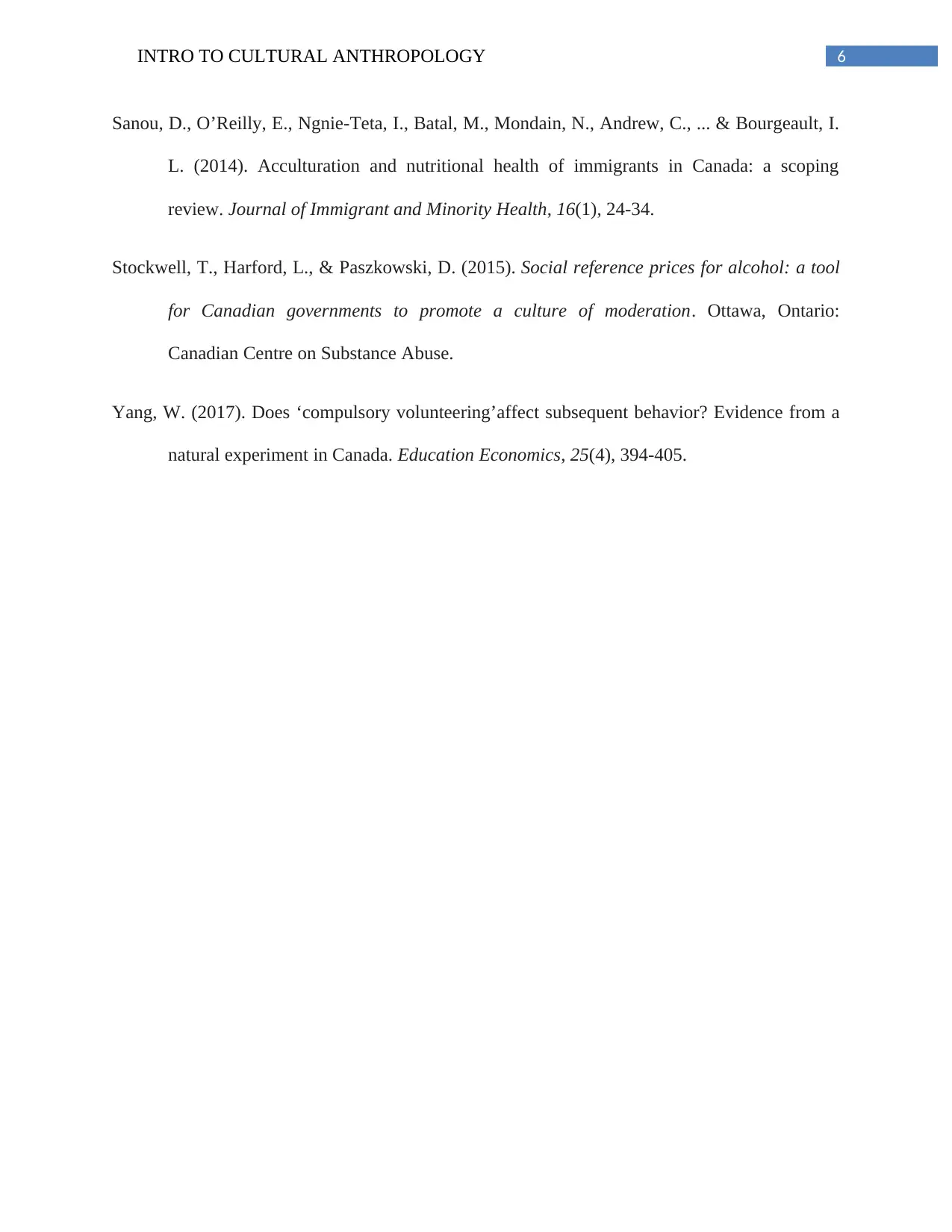
6INTRO TO CULTURAL ANTHROPOLOGY
Sanou, D., O’Reilly, E., Ngnie-Teta, I., Batal, M., Mondain, N., Andrew, C., ... & Bourgeault, I.
L. (2014). Acculturation and nutritional health of immigrants in Canada: a scoping
review. Journal of Immigrant and Minority Health, 16(1), 24-34.
Stockwell, T., Harford, L., & Paszkowski, D. (2015). Social reference prices for alcohol: a tool
for Canadian governments to promote a culture of moderation. Ottawa, Ontario:
Canadian Centre on Substance Abuse.
Yang, W. (2017). Does ‘compulsory volunteering’affect subsequent behavior? Evidence from a
natural experiment in Canada. Education Economics, 25(4), 394-405.
Sanou, D., O’Reilly, E., Ngnie-Teta, I., Batal, M., Mondain, N., Andrew, C., ... & Bourgeault, I.
L. (2014). Acculturation and nutritional health of immigrants in Canada: a scoping
review. Journal of Immigrant and Minority Health, 16(1), 24-34.
Stockwell, T., Harford, L., & Paszkowski, D. (2015). Social reference prices for alcohol: a tool
for Canadian governments to promote a culture of moderation. Ottawa, Ontario:
Canadian Centre on Substance Abuse.
Yang, W. (2017). Does ‘compulsory volunteering’affect subsequent behavior? Evidence from a
natural experiment in Canada. Education Economics, 25(4), 394-405.
1 out of 7
Related Documents
Your All-in-One AI-Powered Toolkit for Academic Success.
+13062052269
info@desklib.com
Available 24*7 on WhatsApp / Email
![[object Object]](/_next/static/media/star-bottom.7253800d.svg)
Unlock your academic potential
Copyright © 2020–2025 A2Z Services. All Rights Reserved. Developed and managed by ZUCOL.





